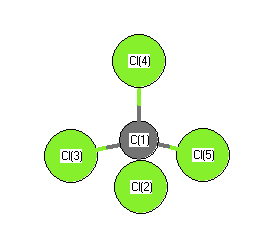Vibrational Frequencies calculated at PBEPBEultrafine/6-31G**
| Mode Number |
Symmetry |
Frequency
(cm-1) |
Scaled Frequency
(cm-1) |
IR Intensities
(km mol-1) |
Raman Act
(Å4/u) |
Dep P |
Dep U |
|---|
| 1 |
A1 |
445 |
439 |
0.00 |
19.34 |
0.00 |
0.00 |
| 2 |
E |
213 |
211 |
0.00 |
4.67 |
0.75 |
0.86 |
| 2 |
E |
213 |
211 |
0.00 |
4.67 |
0.75 |
0.86 |
| 3 |
T2 |
720 |
710 |
227.49 |
1.04 |
0.75 |
0.86 |
| 3 |
T2 |
720 |
710 |
227.49 |
1.04 |
0.75 |
0.86 |
| 3 |
T2 |
720 |
710 |
227.49 |
1.04 |
0.75 |
0.86 |
| 4 |
T2 |
310 |
306 |
0.44 |
6.59 |
0.75 |
0.86 |
| 4 |
T2 |
310 |
306 |
0.44 |
6.59 |
0.75 |
0.86 |
| 4 |
T2 |
310 |
306 |
0.44 |
6.59 |
0.75 |
0.86 |
Unscaled Zero Point Vibrational Energy (zpe) 1981.0 cm
-1
Scaled (by 0.9863) Zero Point Vibrational Energy (zpe) 1953.8 cm
-1
See section
III.C.1 List or set vibrational scaling factors
to change the scale factors used here.
See section
III.C.2
Calculate a vibrational scaling factor for a given set of molecules
to determine the least squares best scaling factor.
Charges, Dipole, Quadrupole and Polarizability
Charges from optimized geometry at PBEPBEultrafine/6-31G**
Charges (e)
| Number |
Element |
Mulliken |
CHELPG |
AIM |
ESP |
| 1 |
C |
-0.431 |
|
|
|
| 2 |
Cl |
0.108 |
|
|
|
| 3 |
Cl |
0.108 |
|
|
|
| 4 |
Cl |
0.108 |
|
|
|
| 5 |
Cl |
0.108 |
|
|
|
Electric dipole moments
Electric dipole components in Debye
(What's a Debye? See section
VII.A.3)
| |
x |
y |
z |
Total |
| |
0.000 |
0.000 |
0.000 |
0.000 |
| CHELPG |
|
|
|
|
| AIM |
|
|
|
|
| ESP |
|
|
|
|
Electric Quadrupole moment
Quadrupole components in D Å
| Primitive |
|---|
| | x | y | z |
|---|
| x |
-54.772 |
0.000 |
0.000 |
| y |
0.000 |
-54.772 |
0.000 |
| z |
0.000 |
0.000 |
-54.772 |
|
| Traceless |
|---|
| | x | y | z |
|---|
| x |
0.000 |
0.000 |
0.000 |
| y |
0.000 |
0.000 |
0.000 |
| z |
0.000 |
0.000 |
0.000 |
|
| Polar |
|---|
| 3z2-r2 | 0.000 |
|---|
| x2-y2 | 0.000 |
|---|
| xy | 0.000 |
|---|
| xz | 0.000 |
|---|
| yz | 0.000 |
|---|
|
Polarizabilities
Components of the polarizability tensor.
Units are
Å
3 (Angstrom cubed)
Change units.
| |
x |
y |
z |
| x |
7.706 |
0.000 |
0.000 |
| y |
0.000 |
7.706 |
0.000 |
| z |
0.000 |
0.000 |
7.706 |
<r2> (average value of r
2) Å
2
| <r2> |
253.272 |
| (<r2>)1/2 |
15.915 |
